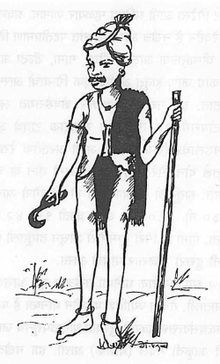Dhangar
The Dhangar is a herding caste of people found in Indian states such as Maharashtra and Uttar Pradesh.

Etymology
The word "Dhangar" may be associated with a term for "cattle wealth" or be derived from the hills in which they lived (Sanskrit "dhang").[1] Ul Hassan noted that some people of his time believed the term to come from the Sanskrit "dhenugar" ("cattle herder") but dismissed that etymology as being "fictitious".[2]
Current situation
Traditionally being shepherds, cowherds, buffalo keepers, blanket and wool weavers, butchers and farmers, the Dhangars were late to take up modern-day education. Though they have a notable population, not only in Maharashtra but also in India at large, and a rich history, today they are still a politically highly disorganised community and are socially, educationally, economically and politically backward. They lived a socially isolated life due to their occupation, wandering mainly in forests, hills and mountains.[3] In Maharashtra, the Dhangars are classified as a Nomadic Tribe but in 2014 were seeking to be reclassified as a Scheduled Tribe in India's system of reservation.[4] The Dhangar community's population in Maharashtra is around one crore (ten million), which is 9% of the total 11.25 crore (112.5 million) population of the state.[5]
The 2011 Census of India for Uttar Pradesh showed the Dhangar classified as a Scheduled Caste, with a population of 43,806.[6]
Subdivisions
Tribes
Initially there were twelve tribes of Dhangar, and they had a division of labour amongst brothers of one family. This later formed three sub-divisions and one half-division. These three being Hatkar (shepherds), Ahir (cowherds) and Khutekar (wool and blanket weavers)/Sangar. The half-division is called Khatik. All sub-castes fall in either of these divisions. All sub-divisions emerge from one stock, and all sub-divisions claim to be a single group of Dhangars. [8] The number three and a half is not a random selection but has a religious and cosmological significance.[9]
All Dhangars of Western Maharashtra and Konkan/Desh regions (formerly Marhatta country), like Holkars who were Dhangar, can be termed "Marathas", but all Marathas are not Dhangars.[10]
References
- Shashi, Shyam Singh (2006). The World of Nomads. Lotus Press. p. 183. ISBN 978-81-8382-051-6. Retrieved 15 November 2011.
- Syed Siraj ul Hassan (1989). The castes and tribes of H.E.H. the Nizam's dominions. Asian Educational Services. ISBN 978-81-206-0488-9. Retrieved 25 July 2011.
- Kaka Kalelkar Commission Report, B D Deshmukh report, Edate report
- Kulkarni, Dhaval (10 February 2014). "Demands for quotas from new groups add to Maharashtra govt's woes". DNA. Retrieved 17 June 2014.
- "Who are Dhangars, why demand for ST status is a challenge for Maharashtra". The Indian Express. 31 July 2018. Retrieved 17 October 2019.
- "A-10 Individual Scheduled Caste Primary Census Abstract Data and its Appendix – Uttar Pradesh". Registrar General & Census Commissioner, India. Retrieved 6 February 2017.
- Cashman, Richard I. (1975). The Myth of the Lokamanya: Tilak and Mass Politics in Maharashtra. University of California Press. p. 11. ISBN 978-0-52002-407-6.
- Dandekar, Ajay (August 1991). "Landscapes in Conflict: Flocks, Hero-stones, and Cult in Early Medieval Maharashtra". Studies in History. 7 (2): 301–324. doi:10.1177/025764309100700207.
- G.D. Sontheimer, The Dhangars: a nomadic pastoral community in a developing agricultural environment; G.D. Sontheimer and L.S. Leshnik, eds., Pastoralists and Nomads in South Asia, Wiesbaden, 1975, p. 140.
- O'Hanlon, Rosalind (2002). Caste, Conflict and Ideology. Cambridge University Press. pp. 16–18. ISBN 978-0-521-52308-0.
Further reading
- Baviskar, B.S., "Cooperatves and caste in Maharashtra: A case study". Sociological Bulletin, XVIII:2:1969:148-166.
- Chaubey Ganesh, "The Dhangar Songs", Folklore, Vol. I No 4, Calcutta, 1958, pp. 22–25.
- G.D. Sontheimer, Pastoral Deities of Western India, London, 1989, p. 104.
- Hutton, John Henry (1946). "Dhangar". Caste in India: its Nature, Function and Origins. Cambridge University Press. p. 278.
- Karve, Irawati, Maharashtra, Land and People. Bombay 1969.
- Malhotra, K. and M. Gadgil, "The ecological basis of the geographical distribution", in People of South Asia.
- Malhotra, K., 1980a, "Inbreeding among the four Dhangar castes of Maharashtra. India". Collegium anthropoloquium, 3.
- Malhotra, K., 1980b, "Matrimonial distances among four Dhangar castes of Maharashtra", South Asian Anthropology, 1.
- Malhotra, K., 1984, "Population structure among the Dhangar caste cluster of Maharashtra", in J.R. Lukacs (ed.), The People of South Asia.
- Prasad Satyanarain. "Modern education among the tribals of Bihar in the second half of the 19th century". Man in India, LI:4:1971:365-393.
- Saksena, R.N., and Chinchalkar, "Dhangars and Gadariyas: The Most backward divisions of Indian tribes and caste". Vanyajati, XXV:2: 1977:14–17.
- Shashi, Shyam Singh (1977). The Shepherds of India: A Socio-cultural Study of Sheep and Cattle-rearing Communities. Sundeep Prakashan.
- Prof. Prabhu N Kokane,"Socio-Legal" Identification of Scheduled Castes/Tribes & Backward Classes(year=2007)Nanded,Maharashtra.
External links
- Dhangar.org
- Pastoral People Worldwide at Food and Agriculture Organization of the United Nations